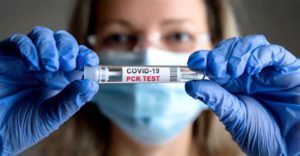40 Facts You Need to Know: The Real Story of “Covid” (1)
Part I: Symptoms
“Covid-19” and the flu have identical symptoms
There are no symptoms or collections of symptoms unique or specific to “covid” and only “covid”. All “covid” symptoms are common to many other diseases and conditions, including the collection of common respiratory infections colloquially known as “the flu”.

This is readily admitted by mainstream sources and “experts”, who routinely describe “covid” symptoms as “flu like”.
According to the US Center for Disease Control’s own website comparing “covid” and the flu:
“You cannot tell the difference between flu and covid-19 just by looking at the symptoms alone because they have some of the same symptoms.”
While the UK’s NHS states:
“The symptoms [of covid] are very similar to symptoms of other illnesses, such as colds and flu.”
While all mainstream sources couch the admission in soft language – “some of the same symptoms”, “very similar” – the truth is the symptoms are identical. The only points of difference ever observed are equivocations on severity and onset time.
This article from Health Partners highlights that “covid” can be both more severe OR milder than the flu, noting that “covid” can sometimes “feel more like a cold”.
While according to the Mayo Clinic, in their article on “covid” vs. the flu, the only difference in symptoms is that they “appear at different times”.
“Ground glass opacities” are NOT unique to “covid”
Early in the pandemic, it was reported that medical imaging revealed what they call “ground glass opacity” in the lungs of suspected “covid” cases and that this was being used to diagnose patients, but ground glass anomalies are not unique to “covid”.
According to a German paper published in the Radiografie journal in 2010:
“Ground glass opacity (GGO) is defined as diffuse pulmonary infiltration [which can be caused by] edema, airspace and interstitial pneumonia. non-infectious pneumonitis as well as tumor manifestations. Physiological processes, such as poor ventilation of dependent lung areas and effects of expiration can also present as ground glass opacity.”
In 2012 the Journal of Respiratory Care published a paper on The Imaging of Acute Respiratory Distress Syndrome which described GGOs:
“Ground-glass opacification on CT is a non-specific sign that reflects an overall reduction in the air content of the affected lung.”
In 2022, the Lancet published a case study from an Indian doctor literally titled Ground glass opacities are not always covid-19.
Another article, published by Health.com in May 2022, underlines that:
“Ground-glass opacities (GCOs) aren’t specific to covid-19. They can show up due to other conditions and infections.”
In short, GGOs are a common presentation of pulmonary illness or injury, and are associated with pneumonia, pneumonitis, tuberculosis, and many other conditions.
A loss of smell and taste is NOT unique to “covid”

As with GGOs, it has been widely reported that a loss of the sense of taste and sense of smell is the telltale sign of “covid”, but that is a known symptom of many upper respiratory infections.
According to a 2001 article published on the website of the University of Connecticut School of Medicine:
“In adults, the two most common causes of smell problems that we see at our Clinic are: (1) Smell loss due to an ongoing process in the nose and/or sinuses such as nasal allergies and (2) smell loss due to injury of the specialized nerve tissue at the top of the nose (or possibly the higher smell pathways in the brain) from a previous viral upper respiratory infection.”
Many common medical conditions are known to cause both acute and chronic damage to the sense of smell and taste, according to the UK’s NHS:
“Changes in sense of smell are most often caused by a cold or flu, sinusitis (sinus infection) [or] allergies (like hay fever).”
Part II: Diagnosis & PCR Tests
It is not possible to clinically diagnose “covid19”
Clinical diagnosis is the practice of diagnosing a disease based on a unique symptom or collection of symptoms. Wiktionary defines it as:
“The estimated identification of the disease underlying a patient’s complaints based merely on signs, symptoms and medical history of the patient rather than on laboratory examination or medical imaging.”
Since “covid19” has no unique symptomatic profile, and since ALL major symptoms of “covid” can potentially apply to literally every common respiratory infection, it is impossible to do to diagnose “covid19” based on symptoms.
Lateral flow tests are unreliable
Throughout the “pandemic” the most frequently used “self-test” for “covid” were Lateral Flow Tests (LFTs). These tests are highly unreliable, and known to return positive test results from household liquids such as fruit juice and soda.
Children in the UK frequently “broke” their LFTs using vinegar or coca-cola in order to create false-positive tests and get a few days off school.
In February 2022, an “expert” told The Guardian that LFTs could create false positives based on the diet of the person being tested, or through “cross-reacting” with a different virus.
In February 2022, it was also reported by a team of “experts” from Imperial College that LFTs can “miss” infectious people. In other words, the official position is that LFTs produce false negative results AND false positive results.
Further, it is acknowledged – and the subject of explainer articles – that LFT and PCR results will often contradict one another. Meaning you can test positive on one, but not the other.
In short, lateral flow tests are of almost no diagnostic value whatsoever.
PCR tests were not designed to diagnose illness
The Reverse-Transcriptase Polymerase Chain Reaction (RT-PCR) test is described in the media as the “gold standard” for “covid” diagnosis.
But Kary Mullis, the Nobel Prize-winning inventor of the process, never intended it to be used as a diagnostic tool and said so publicly:
“PCR is just a process that allows you to make a whole lot of something out of something. It doesn’t tell you that you are sick, or that the thing that you ended up with was going to hurt you or anything like that.”
PCR tests have a history of being inaccurate and unreliable
The “gold standard” PCR tests for “covid” are known to produce a lot of false-positive results, by reacting to DNA material that is not specific to Sars-Cov-2.
A Chinese study found the same patient could get two different results from the same test on the same day. In Germany, tests are known to have reacted to common cold viruses. Some tests in the US even reacted to the negative control sample.
The late President of Tanzania, John Magufuli, submitted samples of goat, pawpaw and motor oil for PCR testing, all came back positive for the virus.
As early as February of 2020 experts were admitting the test was unreliable. Dr. Wang Cheng, president of the Chinese Academy of Medical Sciences told Chinese state television “The accuracy of the tests is only 30-50%”. The Australian government’s own website claimed “There is limited evidence available to assess the accuracy and clinical utility of available covid-19 tests.” And a Portuguese court ruled that PCR tests were “unreliable” and should not be used for diagnosis.
The unreliability of PCR tests is not unique to “covid”, either. A 2006 study found PCR tests for one virus responded to other viruses too. In 2007, reliance on PCR tests resulted in an “outbreak” of Whooping Cough that never actually existed.
You can read detailed breakdowns of the failings of PCR tests here, here and here.

The CT values of the PCR tests are too high
PCR tests are run in cycles, the number of cycles you use to get your result is known as your “cycle threshold” or CT value. Kary Mullis said: “If you have to go more than 40 cycles there is something seriously wrong with your PCR.”
The MIQE PCR guidelines agree, stating: “CT values higher than 40 are suspect because of the implied low efficiency and generally should not be reported”.
Dr. Fauci himself even admitted anything over 35 cycles is almost never culturable.
Dr. Juliet Morrison, virologist at the University of California, Riverside, told the New York Times: “Any test with a cycle threshold above 35 is too sensitive. I’m shocked that people would think that 40 [cycles] could represent a positive. A more reasonable cutoff would be 30 to 35.”
In the same article Dr. Michael Mina, of the Harvard School of Public Health, said the limit should be 30, and the author goes on to point out that reducing the CT from 40 to 30 would have reduced “covid cases” in some states by as much as 90%.
The CDC’s own data suggests no sample over 33 cycles could be cultured, and Germany’s Robert Koch Institute says nothing over 30 cycles is likely to be infectious.
Despite this, it is known almost all the labs in the US are running their tests at least 37 cycles and sometimes as high as 45. The NHS “standard operating procedure” for PCR tests rules set the limit at 40 cycles.
Based on what we know about the CT values, the majority of PCR test results are at best questionable.
The World Health Organization (Twice) Admitted PCR tests produced false positives
In December 2020 WHO put out a briefing memo on the PCR process instructing labs to be wary of high CT values causing false positive results:
“When specimens return a high Ct value, it means that many cycles were required to detect virus. In some circumstances, the distinction between background noise and actual presence of the target virus is difficult to ascertain.”
Then, in January 2021, the WHO released another memo, this time warning that “asymptomatic” positive PCR tests should be re-tested because they might be false positives:
“Where test results do not correspond with the clinical presentation, a new specimen should be taken and retested using the same or different NAT technology.”
These announcements coincided with the initial launch of the “covid vaccines”.
The scientific basis for ALL “covid” tests is questionable
The genome of the Sars-Cov-2 virus was supposedly sequenced by Chinese scientists in December 2019, then published on January 10th 2020. Less than two weeks later, German virologists (Christian Drosten et al.) had allegedly used the genome to create assays for PCR tests.
They wrote a paper, Detection of 2019 novel coronavirus (2019-nCoV) by real-time RT-PCR, which was submitted for publication on January 21st 2020, and then accepted on January 22nd. Meaning the paper was allegedly “peer-reviewed” in less than 24 hours. A process that typically takes weeks.
Since then, a consortium of over forty life scientists has petitioned for the withdrawal of the paper, writing a lengthy report detailing 10 major errors in the paper’s methodology.
They have also requested the release of the journal’s peer-review report, to prove the paper really did pass through the peer-review process. The journal has yet to comply.
The Corman-Drosten assays are the root of every “covid” PCR test in the world. If the paper is questionable, every PCR test is also questionable.
Read the second part of the article
yogaesoteric
May 29, 2023
